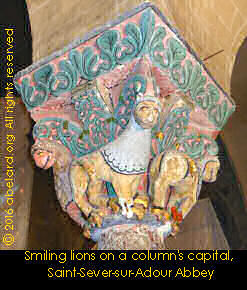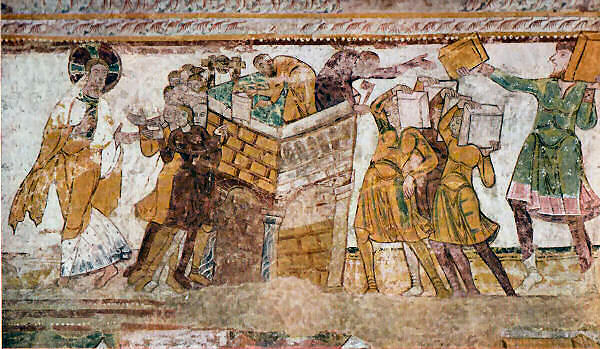|
on first arriving in France - driving
France is
not England
paying
at the péage (toll station) 

Germans
in France 
Reims
cathedral 
Cambrai
cathedral 

France’s
western isles: Ile de Ré

Marianne - a French national symbol, with French definitive stamps
the calendar of the French Revolution
the 6th bridge at Rouen: Pont Gustave Flaubert,
new vertical lift bridge
Futuroscope
Vulcania
the French umbrella & Aurillac
the forest as seen by francois mauriac, and today 
places and playtime
roundabout art of Les Landes
after the whirlwind, in les landes  
50 years old: Citroën DS
the Citroën 2CV:
a French motoring icon
la belle époque 
cathedral labyrinths and mazes in France 
Pic du Midi - observing stars clearly, A64 
Carcassonne, A61: world heritage fortified city 
Grand Palais, Paris
Marianne - a French national symbol, with French definitive stamps
the calendar of the French Revolution
le pique-nique
Hermès scarves

bastide towns
mardi gras! carnival in Basque country
what a hair cut! m & french pop/rock
country life in France: the poultry fair

short biography of Pierre Peter) Abelard

|
"It is well known that the south and south-west of France had during
the early middle-ages commercial relations with the Byzantine empire
and especially with Venice where alone in Italy the traditions of
Byzantine art lingered, and these countries were then the great
mercantile centres of Europe. A colony of Venetian merchants was
planted at Limoges about 988-9: their goods were brought to Aigues-Mortes on the Gulf of Lyon [lion], whence by mules and wagons
they were conveyed to Limoges and forwarded to the north of France and
from Rochelle to the British Isles. The Venetians had a bourse [stock exchange] at Limoges, and their memory was preserved in the names of the streets
and gates even after they themselves had disappeared.
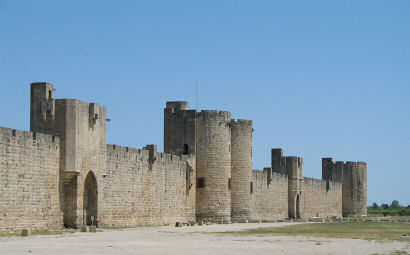
Aigues-Mortes. Image credit: Marc Ryckaert via wiki commons
"It cannot be mere coincidence that it was along this line of commerce
with the East that we find a school of architecture in France which
deliberately made the dome a principle in church architecture; though
Saint Front [Périgueux] alone has adopted the plan of a Byzantine
church [Saint Mark's at Venice] as well as the domical covering."
[p.37, vol. 2, Jackson
]
[Byzantine and Romanesque architecture by T. G. Jackson, 1913]
overview
You can trace a line of development from the early Roman and pagan temples, renamed oratories, then extended into Christian churches and, eventually, into cathedrals.
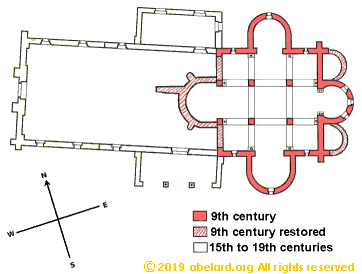
Floor plan of the oratory at Germigny-des-Prés
In the diagram above, you can see the oratory becoming the apse and nave of the proto-church.
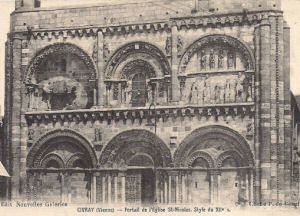 |
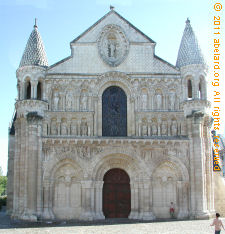 |
| West front of Saint-Nicholas church, Civray |
Romanesque church
(Église de Notre-Dame la Grande, Poitiers) |
"The astonishingly consistent western wall of the
Aquitainian Romanesque church guards the entry into a
surprisingly varied space. In most instances, the interior is vaulted; yet a dome or even a timber roof is often employed instead as
a cover for the nave. Aisles, generally anticipated in basilican churches,
are not a constant feature of any of these structures but rather appear to
relate to and depend upon the overall size of the building. The logic of
an individual structure’s internal arrangement seems at times to have
been deliberately disguised by the application to its west wall of a
lavishly decorated ‘‘stock” facade plan. The disposition of arcaded
forms on the western mural surface often occurs without regard for
internal spatial divisions, and the entry wall frequently towers above
the roof, even extending around or beyond the side walls. The formal
similarities relating the facade at the Abbaye-aux-Dames in Saintes to
that at Parthenay-le-Vieux, for example, conceal fundamental dif
ferences between the original use of domes in the former church
and pointed barrel vaulting in the latter. Despite similarities in the
tripartite arcading on the lower façade levels at both Châtres and
Chadenac, neither building has aisles inside; the former is, in fact,
unexpectedly covered with domes." [Seidal, p. 17]
Barn church: This is a common, approximate term for a cathedral or church where the aisles and the nave are of similar height. This construction is common among Romanesque churches because their structure is more naturally formed with fewer different height levels to the ceilings and vaulting.
In contrast, gothic churches have chapel ceilings that are lower than the side aisle vaulting, which in turn are lower than the nave vaulting, which in turn is lower than the dome or lantern tower over the transept crossing.
barrel vaulting 1
Before the great break-through came with the pointed arch, that led to the walls of windows and light of the great Gothic revival in the mid-twelfth century, churches were primarily built with longitudinal barrel vaults, parellel to the length of the nave, and domes. These were very heavy and put considerable strain on the supporting walls, trying to force them outwards. Gothic architecture allowed for much lighter structures. [See barrel vaulting 2.]

The 8-metre wide barrel vault of the nave at l'Église Saint-Pierre-és-Liens, Préchac, looking towards the west door
The south aisle (to the left) is also barrel-vaulted.
Prior to the Gothic revival were Romanesque edifices, which you enter and see the highlight of the altar. This was the domain of priests and monks, viewed from the mysterious half light where the people gathered in the nave. Thus was the great transition in interior decoration, mood, and culture, sometimes called the mediaeval renaissance.
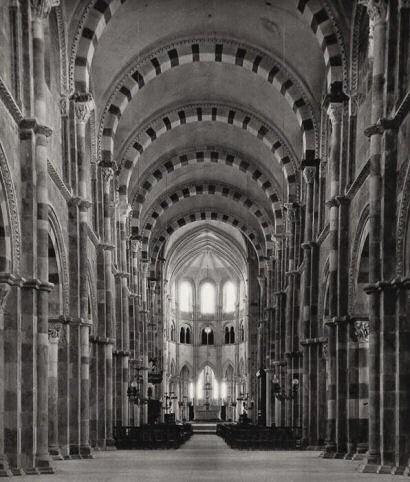
Vezelay cathedral interior, with longitudinal barrel vaulting
Go back a thousand years and more people could not read, so much
education and communication was through pictures in one form or
another. Humans love colour, so the various illustrative media used
the latest colour available, though some colours were not cheap or
easily available. Thus, most common colours tended be earth (mud)
colours of varying levels of red, brown, yellow, etc.
The illustrations were in hand-made books, as stained glass, on wall
paintings and mosaics, as sculpture. The public would meet in the
church and learn from the moral tales of the bible by looking at all the coloured art surrounding them.
There were blues and violets back in the high civilisation of Egypt,
but these were expensive for more backward societies. As
those societies increased in wealth and technology, so richer and more expensive colours
appeared, glass and the glassification of mosaics became more readily available. From the 14th century, printing steadily advanced and books became more available
for the masses.
The medieval church was a riot of colour, even the columns
were painted in patterns. Many of the patterns were copied
straight from woven cloths. The carvings on the capitals developed from plant life and imagined animals as
well as bible stories, making the churches interesting and
entertaining for the customers. Gradually colour is being returned to churches, as shown on the capital just below.
domes, their pendentives, squinches, drums, and lanterns
Bridging the difference
Cathedrals are built as a series of square 'rooms' without internal walls and with columns at the corners of each 'room'.
The nave-transept crossing is essentially a large, wall-less, square room. Adding a hemispherical dome, or a circular or octagonal drum or lantern above it, requires a three-dimensional solution to join the two parts together and provide adequate support for the superstructure.
Pendentives are one such solution, squinches are another. Pendentives are simpler in appearance, but more complex in their geometry.
 Pendentives are one such solution, squinches are another. Pendentives are simpler in appearance, but more complex in their geometry. Pendentives are one such solution, squinches are another. Pendentives are simpler in appearance, but more complex in their geometry.
However, be well aware that there is a great range of constructions to solve this architectural problem, where bands of stone might be decorative or could be structural - is a horizontal band a drum or just prettifying and tidying up, for instance? Here, we endeavour to explain and illustrate the graduations, differences and similarities to be found when looking at pedentives, squinches, drums, domes and lanterns, rather than continuing the verbal hand-waving often to be found, done to to distract from lack of clarity, precision, or knowledge.
Pendentive
Pendentives are concave, triangular segments of a sphere, reminiscent of a sail. Being inverted triangles, they taper to a point at the base and spread at the top. Thus, the upper side of the four pendentives together are a major part of the continuous circular base needed to support a dome above a square room.
Architectural definition of pendentive: one of the concave triangular members that support a dome over a square space.
[Etymology: used from early 18th century. Coming from the French adjective pendentif, -ive, which is derived from the Latin pendent-, pendens (‘hanging down’). Present participle of the verb pendēre, to suspend.]
Another, earlier solution to the transition between a square base and a round or octagonal upper part is the squinch, a wedge of masonry, often hollowed-out, filling in the corner space at the top of the square walls and below the base of the dome or drum.
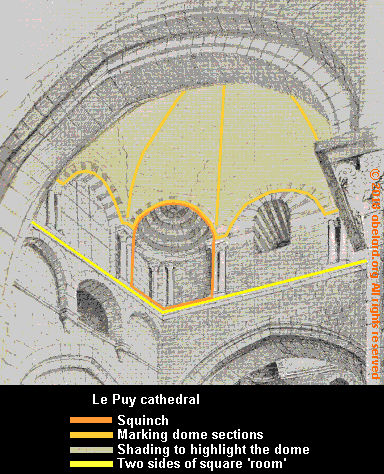 Squinch Squinch
A squinch is an architectural construction that built across an interior angle of a square room to become part of a base for supporting an octagonal or hemispherical dome. There are several construction methods and styles. .
Squinches may be formed by masonry built out from the internal angle in corbelled courses, by filling the corner with a cone placed diagonally, or by building an arch or several concentric arches extending outwards across the corner.
Translated from Viollet Le-Duc: Squinch stacked wedges, having the shape of a shell, that are used for corbelling. The builders of the Middle Ages made great use of squinches to carry eight-pointed stone spires on square towers, watch-towers on the facades, corbelled turrets; they used squinches instead of pendentives to build cupolas on doublet arches resting on four piles.


Above : The dome (marked with an arrow) of Eglise Saint-Croix at Oleron-Sainte-Marie
Right : Shell squinches in the corners of the dome of Eglise Saint-Croix at Oleron-Sainte-Marie
(photoed in deep interior gloom) |
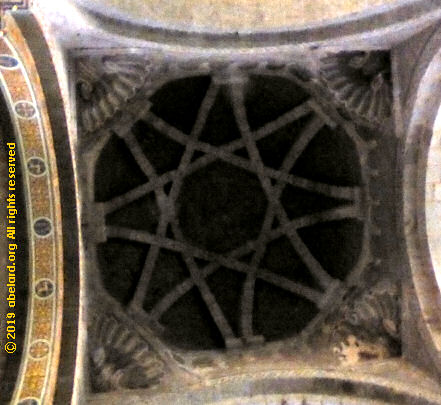 |
The squinches are scallop shell-shaped to indicate that this church is on one of the approach routes of the pilgrimage to Santiago de Compostella. Traditionally, those taking part of this trek across Spain, France, and sometimes even beyond - the pilgrims - wear a scallop shell to indicate their pilgrim status and, previously, as a protective badge.
capitals
The capital is the top protruding stones, the head of a column.
The capital spreads the load to the structures above, providing the transition from column to lintel or arch (see below left). For thousands of years, the capital has been an excuse for all manner of artistic decoration. Originating in ancient Greece, different styles are named after the period when they were prevalent.
By the 11th century A.D., historiated or figured capitals
appeared, decorated with humans, animals, birds and foliage. Notice how similar the concerns of people in 'Romanesque times' compared with today, and how similar their concerns were with 1,000 years earlier. The thief who steals from the market stall or shop, the angry man who beats up his fellow man, the marauding fox, and the cycle of crops. Very, very little has changed despite the wish to think that they were different then, or we are different now.
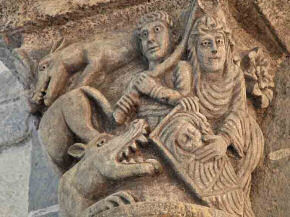
Above: Moses found in the Nile capital, Saint-Nectaire
Note the ferocious crocodile. Will he eat the baby Moses?
Right: David and the lion capital, Vezelay
See the rescued lamb to the left. |
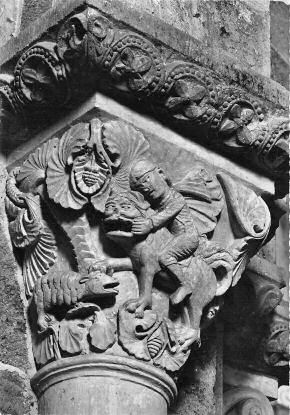 |
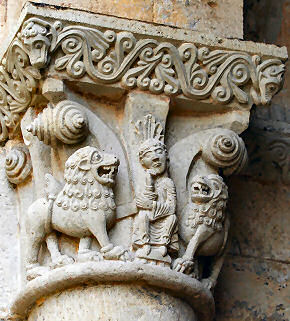 |
Five interpretations of Daniel in the lions' den
Left : Daniel in the lion's den, Abbaye de la Sauve Majeure
Little wonder Daniel is looking complacent, as God closed up the jaws of the lions. Things did not go so well for his rivals who had conspired to get him into this pickle.
Below left : Daniel in the lion's den, Airvault
Below : Daniel in the lion's den, Moissac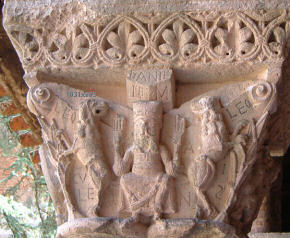 |
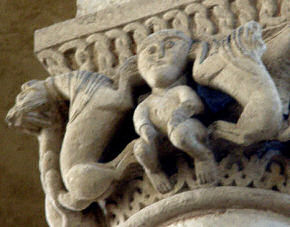 |
Right : Daniel and the lions,
élgise Saint-Nicholas de Civray, Civray, Vienne
In this more artistic version, the big cats seem to be more playful. |
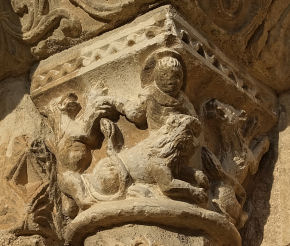 |
 |
Left : Daniel and the lions,
élgise Saint Trophime, Arles
Notice how the artist wraps the lions around the square pillar. Wrapping is a common technique used in columnar art. This sculpture is part of the beautiful portal on the west facade of Saint Trophime, Arles, where it can viewed in full sunlight and close to. |
Right: man with toothache on a capital at Wells cathedral
Pilgrims came after Bishop Goodwin was dug up and found to have a perfect set of teeth. He was thus believed to
able to cure toothache. |
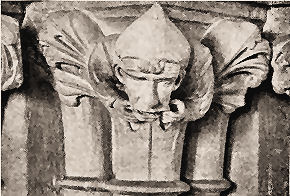
|
Right: people with toothache on a cul-de-lampe at Evron cathedral
In days past, people were taught that being in a state of sin was like having toothache. This could be relieved by confession.
So which story that has come down to us as being a toothache cure is more likely - Bishop Goodwin, or making a confession? I'd rather not guess, or perhaps there was a third possibility.
As you see in the photo to the right, the top section shows a priest giving confession, while below another fellow, on the right, gives confession with other penitents to the left waiting their turn, or is it a blacksmith knocking out the rotting teeth of sufferers?
It is by such analogy that religion is taught. Rather long ago, it was taught visually through the artwork in the churches. |
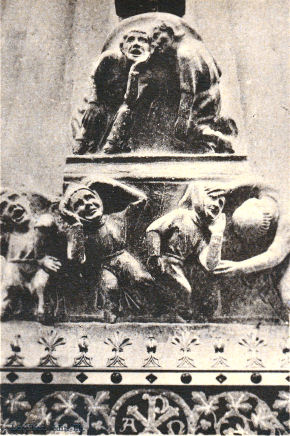 |
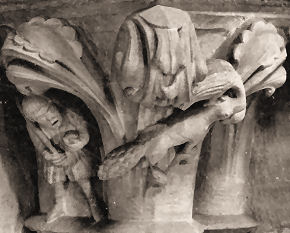
|
Left: capital, Wells Cathedral
A fox has snatched a goose, to the chagrin of the peasant owner. |
Right: capital, Wells Cathedral
Punishing a fruit thief. |
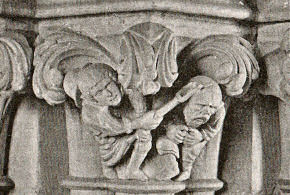
|
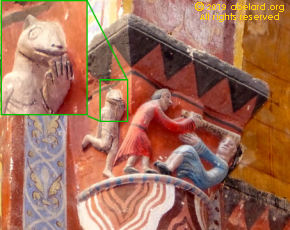 |
Left: Coloured capital at Eglise Saint-Nicholas de Civray
Perhaps the man in blue is being mugged by a
someone bewitched by a demon. |
The Protest-ant sects widely teach the Old Testament whereas, nowadays, the Catholic Church treats the Old Testament as forerunner,and concentrates on the New Testament for dogma and teaching. It is fascinating that in Romanesque times (that is, prior to about 1170), Old Testament themes predominated in these pre-12th century industrial revolution times. By the time of Chartres, astrology signs, lives of saints, the seasonal cycles including farming and production, are somewhat replacing monsters and imagination.
examples of the Romanesque church or cathedral in south-west France
Romanesque religious buildings have several particular characteristics, of which the Roman arch is one. The Roman arch is a hemispherical, thus the width of the arch at its base is twice its height.
at Bordeaux
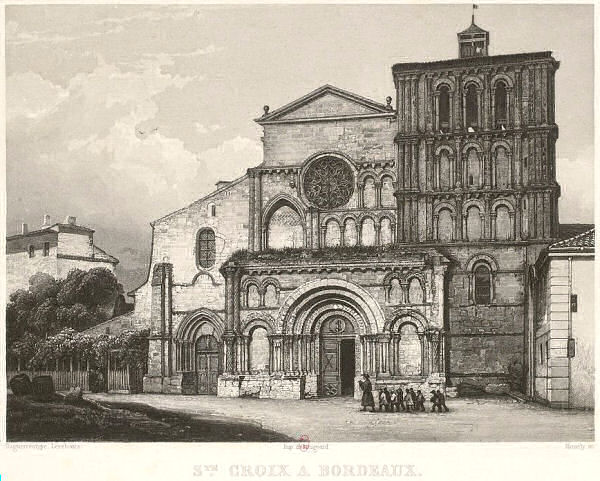
Saint-Croix, Bordeaux (print dates from 1841)

Detail of the portail arch at Saint-Croix, Bordeaux. Image credit: Jcdelorge via wiki commons
Note how the personages in the top row are almost all bent over in order to fit the space available. However, this is not always the case, as can be seen in the methods detailed in another portail just below, where the Elders of the Apocalypse are conveniently seated. A similar carving solution can be seen at Airvault, about fifty kilometres north-west of Poitiers.
8 And when he had taken the book, the four beasts and four and twenty elders fell down before the Lamb, having every one of them harps, and golden vials full of odours, which are the prayers of saints.
[Revelation 5:8 King James Version (KJV)]

Detail of the portail arch at the cathedral Sainte-Marie, Oleron-Sainte-Marie.
Image credit: Mossot via wiki commons
Oleron-Sainte-Marie, near Pau
The cathedral of Sainte-Marie is situated in the centre of the lower, main town. The main portail is worth seeing.
The church of Saint-Croix is located at the top of the steep hill with narrow roads. Being on the Saint Jacques de Compostella pilgrimage, the dome squinches are in the form of shells. The floor is paved with ancient gravestones, now uncovered after a previous curé covered the church's floor with then new-fangled tarmac.
Saint-Pierre, Pathenay-le-Vieux
Outside, this church has a long frieze of modillions that appear to represent domestic cats. In the last hundred years or so since the upper photograph was taken, the tribulations of pollution and neglect now show in the photograph below.
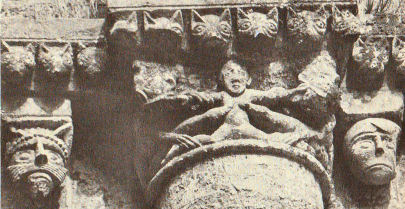 |
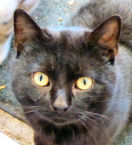
A
photograph of a real cat. |
| Cat modillions, Saint-Pierre, Pathenay-le-Vieux |
 |
| Cat modillions, Saint-Pierre, Pathenay-le-Vieux |
Abbaticale Saint-Philibert de Tournus
barrel vaulting 2
Tournus has a very unusual and innovative arrangement of barrel vaults that lets in much more light. This innovation probably did not catch on as it was soon superceded by the gothic style. There is another example of traverse barrel vaulting at the former Abbaye de Fontenay (now in private hands) at Montbard in the département of Côte-d'Or .
This form of barrel vaulting also very much reduces the pressure on the outside walls, as each barrel vault is balanced against its neighbours, rather than against the north and south aisle pillars or exterior walls. It was a brilliant innovation, not only do the vaults make the stresses less, they also allow the introduction of more light.
Along the length of the nave, the barrel vaults each rise from traverse Roman arches supported on stout columns. These arches are of relatively small diameter (and so quite narrow) probably because the forces from wider barrel vaults would be too great for the wider arches.

Traverse barrel vaulting at Tournus, with visualisation diagram, looking East to West
Cross-section across the Abbaticale Saint-Philibert de Tournus
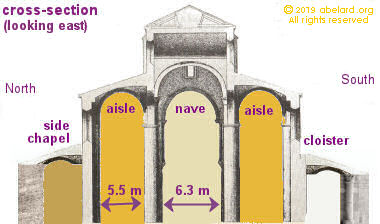
The cross-section above shows the similarity in height of the barrel vaulting in both the nave and the side aisles, as well as the narrowness of the nave and side aisles. [See also "barn church", above.]
Compare the spans at Tournus and at Préchac, whose barrel-vaulted nave is about 8 metres wide, with those of the nave and side aisles of major Gothic cathedrals. For instance, at Chartres cathedral the nave width is 16.4 m, while the side aisles are 8 m wide. At Amiens cathedral, the nave is 14.6 m wide.
Saint-Savin (sur Gartempe), near Poitiers
Probably the best fresco site in France. |
|
| |
Autun cathedral : The tympanum is in good condition, mainly because it was plastered
over in the eighteenth century and so survived the French
Revolution. The tympanum was rediscovered in 1837 and restored, but the
head of Christ
was missing because the plasterers decided it protruded too
much. The head
was only found in 1948, when it was put back in place.
[See Strafford, p.51]
Ganagobie priory church: Home to splendid 12th-century mosaics. The monastery buildings and church were
sold off by the French Revolutionaries. Then, the eastern end was deliberately destroyed in 1794,
which resulted in the mosaics being covered by rubble and forgotten.
Only in the 1890s were they rediscovered and were photographed. The mosaics were then recovered by earth to protect them. In 1975, monks
moved back and started restoring the church.
[See Strafford, p.288]
Saint Michel de Cuxa: Many of the capitals are now on display in New York. They had been
dispersed around southern France when the cloister was dismantled, then purchased from a number of 'owners' by George Barnard and
brought to the Metropolitan Museum using Rockefeller money. The cloister has been partially rebuilt recently with column and
capitals that have been recovered in France.
[See Strafford, p.341]
See also Cathedral destruction by the Huguenots and during the French revolution
bibliography
Fresques romanes des Églises de France
introduction de Paul-Henri Michel |
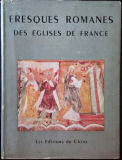 |
éditions du Chêne, hbk, 1949
1974 edition
éditions
Guy Le Prat, hbk
ISBN-10: 2852050056
ISBN-13: 978-2852050051
amazon.com
amazon.co.uk |
|
|
Romanesque churches of France, a traveller's guide
by Peter Strafford |
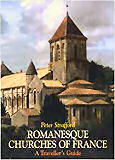 |
Giles de la Mare Publishers, pbk 2005
ISBN-10: 1900357240
ISBN-13: 978-1900357241
shipping weight: 1.6 lb
$24.27 [amazon.com]
£15.99 [amazon.co.uk] {advert} |
|
|
Songs of glory, the Romanesque façades of Aquitaine
by Linda Seidel |
 |
University of Chicago Press, pbk, 1988
ISBN-10: 0226745147
ISBN-13: 978-0226745145
shipping weight: 12.6 ounces (!)
$37.95 [amazon.com]
amazon.co.uk |
|
|
Byzantine and Romanesque architecture
by Thomas Graham Jackson |
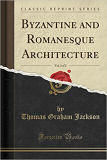 |
Volume 2
Cambridge University Press, 1920, 2nd ed., hbk
reprint
Forgotten Books, 2017, pbk
ISBN-10: 1330340450
ISBN-13: 978-1330340455
£12.59 [amazon.co.uk] {advert}
$16.57 [amazon.com] |
|
|
The cathedral church of Wells
A description of its fabric and a brief history of the episcopal see
by the Rev. Percy Dearmer, M.A. |
 |
George Bell and Sons,
hbk, reprint, 1898
ASIN: B00116QWCM
amazon.com
amazon.co.uk |
|
reprints
Palala Press, 2016, hbk
ISBN-10: 1354718100
ISBN-13: 978-1354718100
£17.95 [amazon.co.uk] {advert}
$23.95 [amazon.com] |
CreateSpace Independent Publishing Platform, 2015, pbk
ISBN-10: 1517128188
ISBN-13: 978-1517128180
$7.99 [amazon.com] |
| |
|
|
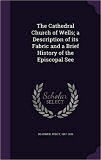 |
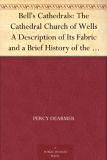 |
end notes
- Le Golfe de Lion is the French name for this part of the Mediterranean Sea. The English (Anglophile) name is the Gulf of Lyon. Incorrectly, and confusingly, the Gulf of Lyon can be called "the Gulf of Lyons", as in the quotation above.
Etymology: There are two theories for the origin of this name:
1. The gulf is named after the large cathedral city of Lyon, which lies on the major river, the Rhone. The Rhone empties into the Mediterranean Sea at this gulf. However, this theory is often rejected because Lyon is seen as "too far" from France's southern coast. Said to have been started to flatter the city of Lyon, this usage disappeared by 1900.
2. The gulf's present name derives from the Middle Ages, coming from the medieval Latin name sinus Leonis or mare Leonis. Found in several historic sources dating back to the 13th century, the suggestion is that the waters were being compared with a lion. This part of the Mediterranean Sea can be regarded as dangerous as a lion thanks to the violent and capricious winds (principally the mistral) that threaten shipping, and in particular small fishing boats.
In Roman times, the classical Latin name was sinus Gallicus, that is, "Gaulish Gulf".
- Useful site for the history of artist's colour.
- Modern printing began in the fifteenth century after
the invention of the printing press by Johannes Gutenberg (1398-1468).
Other earlier societies in China and Egypt used stamps that were
then used to print on cloth. Later on the Chinese began to use wooden
blocks to print onto silk.
In 1476, a printing press was set up in England by William Caxton.
- Exodus 2, King James Version (KJV)
- And there went a man of the house of Levi, and took to wife a daughter of Levi.
- And the woman conceived, and bare a son: and when she saw him that he was a goodly child, she hid him three months.:
- And when she could not longer hide him, she took for him an ark of bulrushes, and daubed it with slime and with pitch, and put the child therein; and she laid it in the flags by the river's brink.
- And his sister stood afar off, to wit what would be done to him.
- And the daughter of Pharaoh came down to wash herself at the river; and her maidens walked along by the river's side; and when she saw the ark among the flags, she sent her maid to fetch it.
- And when she had opened it, she saw the child: and, behold, the babe wept. And she had compassion on him, and said, This is one of the Hebrews' children.
- Then said his sister to Pharaoh's daughter, Shall I go and call to thee a nurse of the Hebrew women, that she may nurse the child for thee?
- And Pharaoh's daughter said to her, Go. And the maid went and called the child's mother.
- And Pharaoh's daughter said unto her, Take this child away, and nurse it for me, and I will give thee thy wages. And the women took the child, and nursed it.
- And the child grew, and she brought him unto Pharaoh's daughter, and he became her son. And she called his name Moses: and she said, Because I drew him out of the water.
- 1 Samuel 17:34-36, King James Version (KJV)
- And David said unto Saul, Thy servant kept his father's sheep, and there came a lion, and a bear, and took a lamb out of the flock:
- And I went out after him, and smote him, and delivered it out of his mouth: and when he arose against me, I caught him by his beard, and smote him, and slew him.
- Daniel 6, King James Version (KJV)
- It pleased Darius to set over the kingdom an hundred and twenty princes, which should be over the whole kingdom;
- And over these three presidents; of whom Daniel was first: that the princes might give accounts unto them, and the king should have no damage.
- Then this Daniel was preferred above the presidents and princes, because an excellent spirit was in him; and the king thought to set him over the whole realm.
- Then the presidents and princes sought to find occasion against Daniel concerning the kingdom; but they could find none occasion nor fault; forasmuch as he was faithful, neither was there any error or fault found in him.
- Then said these men, We shall not find any occasion against this Daniel, except we find it against him concerning the law of his God.
- Then these presidents and princes assembled together to the king, and said thus unto him, King Darius, live for ever.
- All the presidents of the kingdom, the governors, and the princes, the counsellors, and the captains, have consulted together to establish a royal statute, and to make a firm decree, that whosoever shall ask a petition of any God or man for thirty days, save of thee, O king, he shall be cast into the den of lions.
- Now, O king, establish the decree, and sign the writing, that it be not changed, according to the law of the Medes and Persians, which altereth not.
- Wherefore king Darius signed the writing and the decree.
- Now when Daniel knew that the writing was signed, he went into his house; and his windows being open in his chamber toward Jerusalem, he kneeled upon his knees three times a day, and prayed, and gave thanks before his God, as he did aforetime.
- Then these men assembled, and found Daniel praying and making supplication before his God.
- Then they came near, and spake before the king concerning the king's decree; Hast thou not signed a decree, that every man that shall ask a petition of any God or man within thirty days, save of thee, O king, shall be cast into the den of lions? The king answered and said, The thing is true, according to the law of the Medes and Persians, which altereth not.
- Then answered they and said before the king, That Daniel, which is of the children of the captivity of Judah, regardeth not thee, O king, nor the decree that thou hast signed, but maketh his petition three times a day.
- Then the king, when he heard these words, was sore displeased with himself, and set his heart on Daniel to deliver him: and he laboured till the going down of the sun to deliver him.
- Then these men assembled unto the king, and said unto the king, Know, O king, that the law of the Medes and Persians is, That no decree nor statute which the king establisheth may be changed.
- Then the king commanded, and they brought Daniel, and cast him into the den of lions. Now the king spake and said unto Daniel, Thy God whom thou servest continually, he will deliver thee.
- And a stone was brought, and laid upon the mouth of the den; and the king sealed it with his own signet, and with the signet of his lords; that the purpose might not be changed concerning Daniel.
- Then the king went to his palace, and passed the night fasting: neither were instruments of musick brought before him: and his sleep went from him.
- Then the king arose very early in the morning, and went in haste unto the den of lions.
- And when he came to the den, he cried with a lamentable voice unto Daniel: and the king spake and said to Daniel, O Daniel, servant of the living God, is thy God, whom thou servest continually, able to deliver thee from the lions?
- Then said Daniel unto the king, O king, live for ever.
- My God hath sent his angel, and hath shut the lions' mouths, that they have not hurt me: forasmuch as before him innocency was found in me; and also before thee, O king, have I done no hurt.
- Then was the king exceedingly glad for him, and commanded that they should take Daniel up out of the den. So Daniel was taken up out of the den, and no manner of hurt was found upon him, because he believed in his God.
- And the king commanded, and they brought those men which had accused Daniel, and they cast them into the den of lions, them, their children, and their wives; and the lions had the mastery of them, and brake all their bones in pieces or ever they came at the bottom of the den.
- Then king Darius wrote unto all people, nations, and languages, that dwell in all the earth; Peace be multiplied unto you.
- I make a decree, That in every dominion of my kingdom men tremble and fear before the God of Daniel: for he is the living God, and stedfast for ever, and his kingdom that which shall not be destroyed, and his dominion shall be even unto the end.
- He delivereth and rescueth, and he worketh signs and wonders in heaven and in earth, who hath delivered Daniel from the power of the lions.
- So this Daniel prospered in the reign of Darius, and in the reign of Cyrus the Persia.
See also The Daniel Jazz by Vachel Lindsay
- abbatiale
- The church of an abbey.
- cul-de-lampe
- Literally, the bottom of a lamp!
Originally, this was a pedestal jutting from a wall that was a support for a lamp. These pedestals became ornately decorated. The name persisted although the pedestal was used as a support for sculptures and other objects. In the case of the toothache cul-de-lampe, the cul-de-lampe supports a substantial crucifix.
A cul-de-lampe is also a typographic ornament upon which a block of text rests. A typographic cul-de-lampe can be form of a block of words as in the illustration below right. There, the text cul-de-lampe (tinted in blue) supports both an illustration and some text that accompanies the illustration (tinted in pink).
 cul-de-lampe
cul-de-lampe from book published in Paris, 1846 right: cul-de-lampe from book published in Venice, 1499. See how the illustration is supported by a cul-de-lampe of text. |
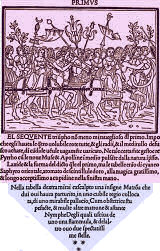 |
|
|


















